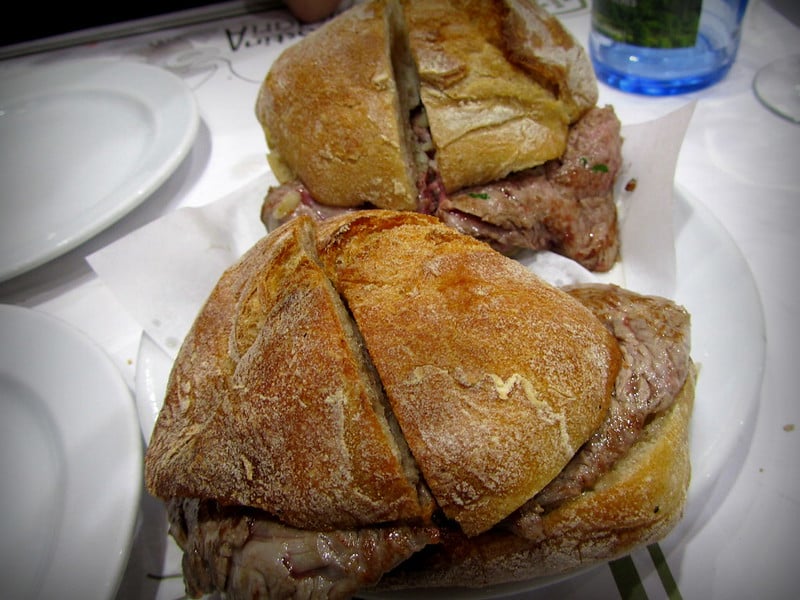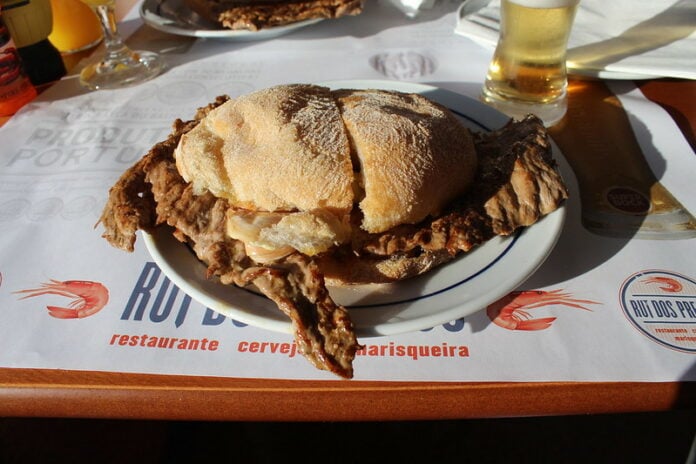The Prego: A Classic Portuguese Sandwich
The prego sandwich is one of the ultimate comfort foods in Portugal. Served both as a simple bar snack and also as a dessert after a heavy seafood meal, the prego stands as one of the gastronomic delights in the hearts of the Portuguese. Its robust flavor and easy accessibility makes it a beloved choice for a quick, satisfying meal. This sandwich might not be as globally renowned as the Pastel de Nata, but it certainly deserves its spotlight for its unique taste and cultural significance.
What is a Prego Sandwich?
So, what exactly is a Prego? It’s essentially a garlic steak sandwich, known for its tender meat and aromatic seasoning. The word ‘prego’ in Portuguese means ‘nail,’ related to the ‘nailing’ of the garlic-infused steak to the bread. Paying homage to the “nail,” when preparing this dish, it is often encouraged to nail the garlic into the meat. Soaking the meat in one of Portugal’s classic beers, Sagres or Superbock, ties the sandwich even closer to the Portuguese culture.

Origin and Cultural Significance
The prego’s history is rooted in Portugal’s appreciation for hearty, no-frills food. Originating as a working-class meal, it quickly became popular across the country for its affordability and satisfying nature. Every region in Portugal adds its twist to the prego, but the essence remains the same – a celebration of good, honest food served in bars, from food trucks, and at festivals throughout the country all year long. It’s often enjoyed at local tascas (small eateries) where conversation flows as freely as the wine.
The prego is a social dish, meant to be shared and savored among friends and family. It’s common to see people gathering around a table, prego sandwiches in hand, discussing their day or debating over a football match.
Prego Sandwich Recipe
Check out our version of the prego sandwich below eager to share our favorite Prego recipe with you!
Ingredients
2 portions (depends on your level of hunger)
For the Steak:
- 4 thin slices of beef (sirloin or tenderloin)
- 4 cloves of garlic, finely chopped
- Salt and pepper to taste (Bonus points if you use Saldomar salt or Saloio olive oil, both products of Portugal)
- 2 tablespoons of olive oil
- A dab of butter
- 4 Portuguese rolls or similar crusty bread
For the Marinade:
- 1/4 cup of Sagres or Superbock beer (or your local beer)
- 2 cloves of garlic, crushed
- 2 bay leaves
- Salt and pepper to taste
- Paprika to taste
- Additional options: mustard and piri piri or hot sauce
Instructions
Preparing the Steak:
- Combine the paprika, crushed garlic, salt, and pepper in a bowl. Add the steak slices and let them marinate for at least 30 minutes, or overnight for a more intense flavor.
- Heat olive oil and butter in a skillet over medium-high heat. Add bay leaves for even more flavor. Remove the steak from the marinade (discard the marinade) and cook for about 2-3 minutes on each side, or until desired doneness. Pour the beer into the skillet. You may also add some piri piri sauce and mustard. Turn the bubbling mixture down to a low simmer.
- Put your steaks back into this simmering mixture. The longer you let the steak sit in this mixture, the more flavor it will soak up. Remove your steak and prepare to add it to the rolls.
Assembling the Sandwich:
- Slice the Portuguese rolls in half and lightly toast them.
- Place the cooked steaks on the toasted bread, topping each with some of the garlic-infused oil from the skillet.
- Season with a little more salt and pepper if desired. Serve immediately.
Variations of the Prego Sandwich
While the basic ingredients of the prego remain the same, regional variations add a unique twist to this classic dish. In some parts of Portugal, the prego is served with a fried egg on top, known as a “prego no prato.” In others, it’s drizzled with a spicy piri-piri sauce for an extra kick.
The bread used can also vary, from the traditional Portuguese rolls to the more crusty and hearty pão caseiro (homemade bread). Some chefs even add a slice of ham or cheese to elevate the dish further.



